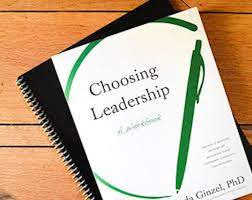“Leadership is a choice.”

Professor Linda Ginzel of the University of Chicago’s Booth School of Business begins her book, Choosing Leadership: A Workbook, with that deceptively simple sentence. It’s a powerful claim, an assertion that carries with it expectations and consequences. Leadership, she asserts, is a “skill that needs to be constantly practiced and developed.” The workbook outlines her philosophy and guides the reader through exercises and reflections to sharpen that choice.
The book is sector agnostic. It could be applied equally effectively to the military or to a non-profit. And it is most definitely a workbook, not a traditional narrative It begins by asking for the reader’s “leadership story” – a narrative that gets one thinking beyond table pounding charismatic leadership. Ginzel proposes being a champion as a way of understanding leadership. Championing something means advocating something that is important. Accordingly, leadership is more verb than noun; it’s about action and movement.
Ginzel is careful to avoid leadership cliches. She stresses that lowercase “leadership” – which is about small, consistent choices – is just as valuable as uppercase “Leadership” – which is about big, transformational change. Both are vital. Borrowing from Kurt Lewin, an influential social psychologist, Ginzel emphasizes three steps to change: 1) unfreeze (understand the need and motivation to change); 2) Change (move toward different behavior); 3) Refreeze (solidify the change and make the new behavior the norm).
In Ginzel’s chapter on gist, or core essence, she asks us to write about our core values, what we believe. To do this effectively, our values cannot be too abstract or concrete. Rather, they are applicable and relevant at an individual, group and societal level. It’s a very interesting chapter and one of the exercises she suggests to convey gist, writing a short commencement speech, is an effective tool.
By the way, I not only read the book, I wrote all the exercises. Ginzel offers writing exercises and prompts throughout. Doing them well promotes reflection and commitment.
Having established a philosophical and personal framework for how we understand leadership, Ginzel turns to experience: what can we learn from others? And what can we learn from our own history? She proposes that we develop a learning framework, a more systematic way to investigate and learn from these questions. It’s a simple exercise and yet one that I would not have considered without the suggestion. Sure, I read regularly and note articles and books and stories. But as for more systematically investigating how they help to explain more about leadership? That’s a different direction for me altogether.
Ginzel’s questions and prompts focus on relationships: how we interact with each other, what we give and what we take away. Leadership, after all, is fundamentally social. It’s about people. If we’re curious – and one of her exercises involves becoming a reporter interviewing someone – we can learn about someone different and learn about ourselves. And it’s in the pivot to self that Ginzel brings the themes of the book together. The questions she raises about identity, values, direction and meaning have to be answered if we are to lead with integrity (pace Brene Brown).
The book concludes with some cautionary tales, some regular exercises, and reminders about how to play to our strengths, to be our best selves. It’s a powerful workbook and I recommend it heartily. And a big thanks to the friend and colleague who shared it with me.
David Potash